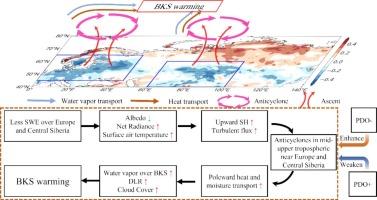北极气温对欧亚大陆早春雪盖变化的年际响应
IF 4.4
2区 地球科学
Q1 METEOROLOGY & ATMOSPHERIC SCIENCES
引用次数: 0
摘要
积雪变化可能对区域和大尺度环流和气候异常产生深远影响。以前的研究集中在它们对中低纬度天气的影响上,而没有考虑对北极气候的影响。本文认为,欧洲和西伯利亚中部的积雪是巴伦支-喀拉海(BKS)早春2m温度年际变化的重要陆地因子。在欧洲和西伯利亚中部积雪较少的年份,地表存在正辐射强迫,这可能导致地表气温升高,导致地表感热通量上升异常。相应的,对流层中高层出现异常反气旋,伴随着欧洲北部的西南风和西伯利亚中部西侧的南风增强,增强了大气热量和水分向BKS的输送和保存。因此,这种变化增加了BKS上的下潜长波辐射和T2m。此外,大多数CMIP6模式和多模式集合(MME)结果都可以识别欧亚SWE与BKS T2m的负相关。此外,欧亚SWE-Arctic T2m连接的多年代际波动与PDO指数存在强烈的非相位,这可以在CMIP6 MME结果中有效捕获。此外,在两个不同的PDO期中,BKS - T2m主要受P1(1962-1977)期间西伯利亚中部SWE变化的影响,相反,P3(1999-2012)期间欧洲SWE变化的影响主要。本文章由计算机程序翻译,如有差异,请以英文原文为准。

Interannual responses of Arctic temperatures to Eurasian snow cover variations in early spring
Variations in snow cover could have profound impacts on regional and large-scale circulations and climate anomalies. Previous studies have focused on their effects on mid- to low-latitude weather without considering the impacts on the Arctic climate. Here, we propose that the snow cover in Europe and Central Siberia is an important land factor for the early spring 2 m temperature (T2m) interannual variability in the Barents–Kara Sea (BKS). In years when there is less snow over Europe and Central Siberia, there are positive radiative forcing at the surface, which can lead to elevated surface air temperatures, contributing to upward surface sensible heat flux anomalies. Correspondingly, anomalous anticyclones appear in the mid-upper troposphere, accompanied by enhanced southwesterly winds over the northern side of Europe and southerly winds over the western side of Central Siberia, enhancing the transport of atmospheric heat and moisture to the BKS and their conservation. Such variations consequently increase the downwelling longwave radiation and T2m over the BKS. Moreover, the negative correlation between Eurasian SWE and BKS T2m can be identified by most CMIP6 models and by multi-model ensemble (MME) results. Additionally, the multidecadal fluctuations in the Eurasian SWE–Arctic T2m connection are strongly out of phase with the PDO index, which can be effectively captured in the CMIP6 MME results. Furthermore, among two different PDO- periods, the BKS T2m were influenced mainly by variation in SWE in Central Siberia during P1 (1962–1977) and, conversely, were impacted mainly by variation in SWE in Europe during P3 (1999–2012).
求助全文
通过发布文献求助,成功后即可免费获取论文全文。
去求助
来源期刊

Atmospheric Research
地学-气象与大气科学
CiteScore
9.40
自引率
10.90%
发文量
460
审稿时长
47 days
期刊介绍:
The journal publishes scientific papers (research papers, review articles, letters and notes) dealing with the part of the atmosphere where meteorological events occur. Attention is given to all processes extending from the earth surface to the tropopause, but special emphasis continues to be devoted to the physics of clouds, mesoscale meteorology and air pollution, i.e. atmospheric aerosols; microphysical processes; cloud dynamics and thermodynamics; numerical simulation, climatology, climate change and weather modification.
 求助内容:
求助内容: 应助结果提醒方式:
应助结果提醒方式:


